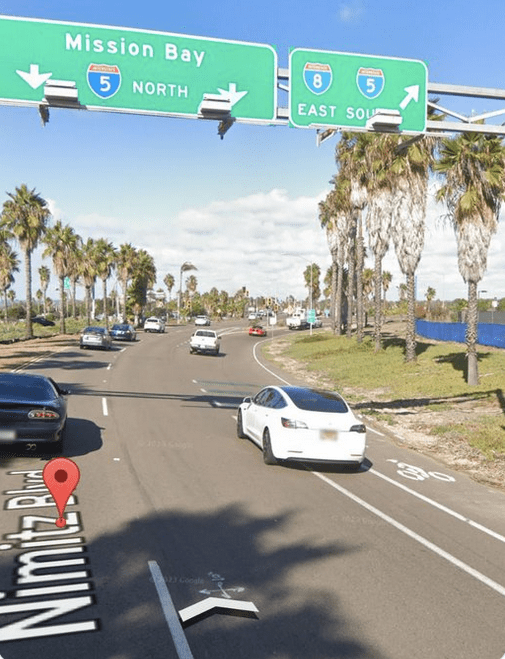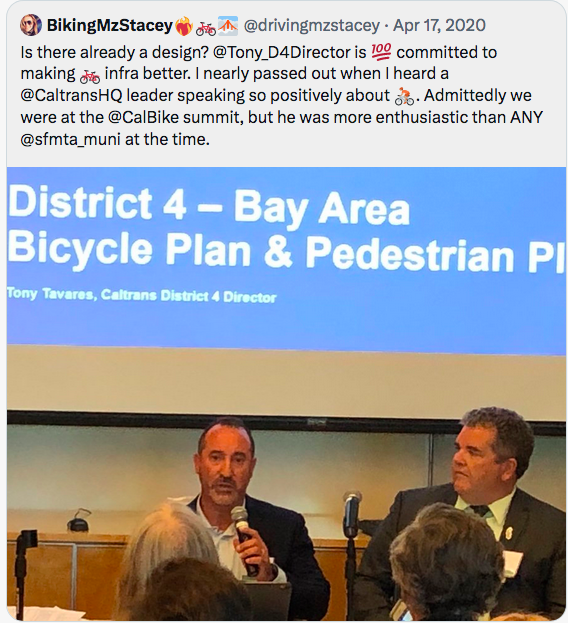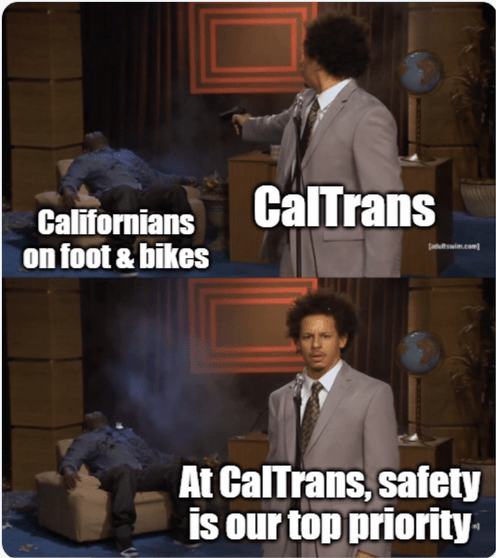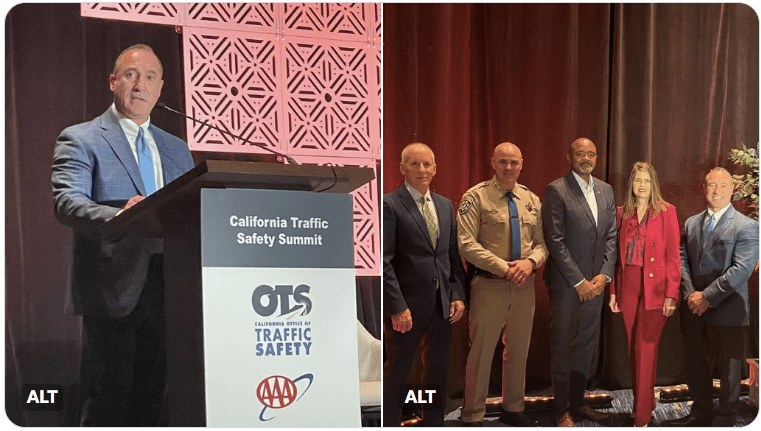Note: this post has been corrected to reflect that the sponsors of the summit were OTS and the American Automobile Association (AAA).
"At Caltrans, safety is our top priority," declares a tweet - a xeet? - from Caltrans Director Tony Tavares. The xeet is accompanied by photos of people posing at the California Traffic Safety Summit., which is being hosted by the Office of Traffic Safety (OTS) and the American Automobile Association (AAA).
"Gathering with our safety partners is a big part of how we keep that message front and center. Each of us has the same goal - to make sure all CA travelers get to where they need to go – safely," the xeet continues.
At Caltrans, safety is our top priority. Gathering with our safety partners is a big part of how we keep that message front and center. Each of us has the same goal - to make sure all CA travelers get to where they need to go – safely. #CATSS2023 #RoadSafety pic.twitter.com/inog3bFTvS
— Tony Tavares (@Tony_CTDirector) November 7, 2023
Swiftly came the responses, and they were brutal - and fair. And they brought receipts. Many came from people whose daily experience screams at them that safety is clearly not the top priority for the state transportation department.
"Can you make this safer?" asked OB Cycler. "I have to ride it everyday and I'm scared that one day I won't come home to my family." The route they're talking about looks a lot like a freeway, but actually is only a freeway-adjacent Caltrans-controlled road. And yes, that is a bike lane there on the right. Really.

This photo could just stand in for the rest of the responses, which basically said: "Nope."
"No, it’s not," wrote George Spies. "Driver convenience and vehicle throughput are your top priorities. If safety was your top priority, our surface highways, our on and off ramps would be engineered entirely differently, and your default design approach would include constraints on vehicle speeds."
"From my perspective, your top priority is the fast and efficient flow of traffic regardless of its negative impact on health and environment. Safety is somewhere further down the list, like third or fourth?" wrote Brer Bear, giving Caltrans the benefit of the doubt.
"You denied a bike lane under the 242 overpass. The bike lane just ends right next to the freeway onramp. Caltrans doesn’t care about cyclists or pedestrians," wrote Ryan.
"The most dangerous places to ride a bike in my community are near Caltrans freeway ramps and access roads because the design of these roads does not prioritize safety for people walking or biking," wrote John Lloyd.
"This is deeply offensive and inappropriate," objected Matthew Lewis. "No one at Caltrans should be using the word 'safety' while your engineers continue to condescend to the families of the dead victims of your roadway designs."
"If safety were the top priority, Caltrans projects would look a lot different," wrote Warren Wells. "In Marin, a $12M project to repave SR 131 is neglecting to install a safe crosswalk here, where kids run across the road today to reach the bus stop on the far side. Help me understand."
He includes a photo, to make the situation clear even to a car-addled brain. "Here's the intersection, with bus stops on both sides, yet no crosswalk or refuge."

"Caltrans manages some of the deadliest streets in California. Wide streets with no sidewalk or protected infrastructure for vulnerable road users such as mobility scooter users or bicyclists. Stop maintaining roads that get us killed." This response, from BikeLanesLA, accompanies a map showing fatal crashes along the Pacific Coast Highway - including the one that recently killed four Pepperdine students.

"The high injury corridors in my city are owned by Caltrans," wrote Bella Chu. "I travel primarily by foot and bike. Crossing these roads on foot is scary, unpleasant and dangerous. Caltrans prioritizes the throughput and storage of cars-inanimate objects-over my mobility, health, safety and life."
"I'd LIKE to think safety is a top priority for ALL road users," responded Medium Rick. "However I just finished a white knuckle commute by bicycle on Hwy 1 in SoCal. Your (lack of) actions speak much louder than your words, Mr. Director."
"One of your PMs told us you couldn’t protect bike lanes downtown because it would create traffic," wrote Scrub, a situation familiar to many advocates. "Pretty sure that’s prioritizing high-speed throughput over safety. Your agency is literally the obstacle standing in the way of our city making its own safety improvements."
BikingMzStacey wrote: "We need less messaging and more concrete between people walking & biking and motorists. The slower they drive, the safer EVERYONE is. Road diets, not highway widening. Do you remember this guy? I do. He gave me hope.

Some responders just dispensed with words:

Presumably the conference was for the Office of Traffic Safety to celebrate achievements and discuss future actions. But what has it achieved? And what is its focus for the future?
OTS is a funding porthole, passing out mostly federal and some state money for safety projects and programs. Some of them are truly worthy; for example, they fund some of the key safety work being done at SafeTrec at UC Berkeley.
OTS also creates and manages public safety campaigns that teach us that vulnerable people on foot and on bike are just as dangerous as drivers. Those campaigns are frequently punching bags for advocates.
But the majority of OTS funding goes out in the form of grants for police traffic enforcement, most of it for short-term “sting” operations that have little lasting impact. They also include no requirements to produce any particular safety outcomes, other than reporting the number of citations issued. And many of those local police enforcement programs make a point of “balancing” citations among modes, instead of concentrating on the most dangerous behaviors. This has lead to negative outcomes like people not wanting to ride a bike anymore because they were issued a ticket for not putting their foot on the ground at a stop sign along a bicycle route.
OTS also prohibits funding from going to automated traffic enforcement systems, like the newly-allowed-in-limited-cities speed cameras - a move that was opposed by law enforcement groups.
Director Tavares and OTS: do better. Just saying that safety is your top priority sounds like hot air - and people notice when there is no meaningful action backing up your claims.






